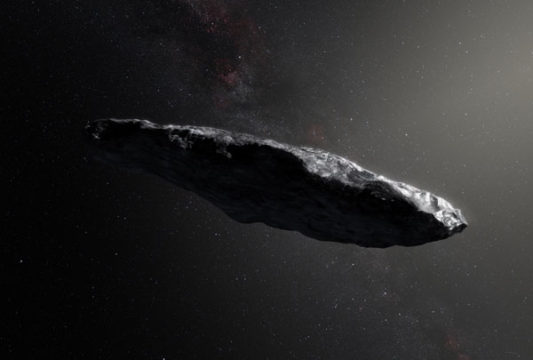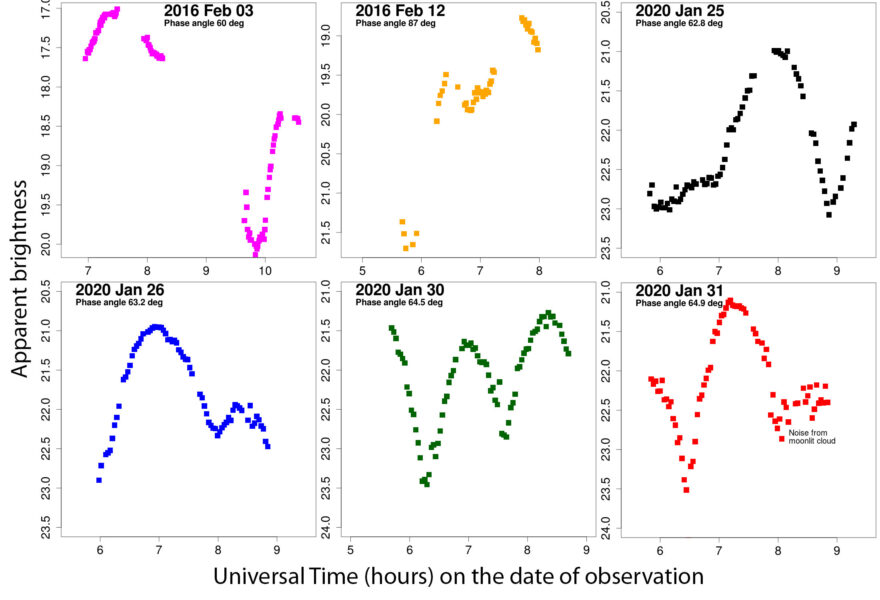Astronomers have observed an object that seems like ‘Oumuamua — but unlike the first known interstellar visitor, this one has probably been a solar system denizen for billions of years.
When interstellar object 1I/ ‘Oumuamua was first spotted tumbling through the solar system in 2017, we’d never seen anything like it. Among many unexplained oddities was its shape: With an aspect ratio of 6:6:1, it’s basically an otherworldly pancake — unlike anything we’d seen in the solar system.

ESO / M. Kornmesser
But it might not be in a class all on its own after all. At the Division for Planetary Sciences meeting in October, Ari Heinze (now at University of Washington) reported preliminary results for an asteroid, 2016 AK193, that behaves remarkably like ‘Oumuamua: It tumbles like the interstellar object did, and it seems to be just as elongated to boot.
But unlike ‘Oumuamua, this asteroid is not a new arrival; it has probably been going around the Sun for billions of years. Time will tell if its origins shed light on ‘Oumuamua’s mysteries.
A Shape Analog
Astronomers observed ‘Oumuamua as it was speeding out of the solar system (it had already swung around the Sun when they spotted it), and its wildly varying brightness immediately indicated two strange things: First, it was tumbling, rather than spinning around an axis. Second, its shape was surprisingly stretched out.
The shape was a puzzle because until that point, the most elongated asteroid that astronomers had observed was 216 Kleopatra, which has the shape of a dog bone (it’s probably a contact binary), with an aspect ratio of 3:1.

NSSDC / NASA
However, when Heinze added measurements of 2016 AK193, taken using the Gemini Observatory in 2020, to a couple days of observations taken back in 2016, he realized that what he had found was a tumbling object roughly the same size as ‘Oumuamua, and possibly as elongated, too.
“‘Oumuamua was a huge mystery because there has literally never been anything like that seen before,” says Darryl Seligman (University of Chicago), who was not involved in the observations. “So if there's anything that's close to that in the solar system, just from that standpoint, it's worth following up.”
Follow-up will take some patience, though — 2016 AK193 is a near-Earth object, but that doesn’t mean it’s near Earth at all times. It won’t come close enough to observe again until 2029, Heinze says. When it does, it’ll approach within 0.05 astronomical unit of Earth, appearing at about 18th magnitude.
“Hopefully there will be some detailed studies then (e.g., radar imaging plus lots more photometry),” Heinze says, “but there is very little prospect for additional useful measurements in the intervening seven years.”

ESO / K. Meech et al.

Aren Heinze
Same Shape, Different Age
Still, the asteroid’s mere existence is intriguing, because it's far from interstellar — it has probably been in the solar system for billions of years. ‘Oumuamua, on the other hand, is more likely young, less than 100 million years old based on its incoming trajectory.
“’Oumuamua’s age is subtly the weirdest thing,” Seligman says. Objects in the galaxy orbit its center, and the older an object is, the more likely it is to have gravitationally ricocheted off another object, out of the galactic plane. ‘Oumuamua, though, came in almost exactly along the galactic plane, which means that any theories on its nature and origin have to also explain its youth.
That’s partly why many explanations of ‘Oumuamua have focused on exotic ices: Seligman has himself speculated it was made of hydrogen ice, recently tossed out of an interstellar cloud. Others have suggested it was made of nitrogen ice, chipped off a Pluto-like body. Harsh sunlight would ablate such ices like a bar of soap in the shower, Seligman says, reshaping the body into a mere sliver of its former self.
It’s also possible the object contains more mundane carbon monoxide ice, like distant solar system objects and like 2I/Borisov, the second interstellar object. Observations didn’t catch a coma around ‘Oumuamua, but as Seligman points out, “Comets turn on and off all the time.” But carbon monoxide ice doesn’t ablate as quickly, so this scenario doesn’t explain the shape as well, he adds.
Future observations of 2016 AK193 will help put such ideas to the test. Its current near-Earth orbit is unstable, Heinze notes, and will only last some 100 million years. It's possible this object used to belong to the main belt before a gravitational encounter redirected it, and that nudge might even have precipitated its reshaping. More and better observations will help us understand its past.
While 2029 may seem a long time to wait for follow-up, it’s better than what we’ll get from ‘Oumuamua. It’s already well on its way out of the solar system, and it’ll pass Neptune’s orbit next year. As of yet, no single theory explains all our observations of this object. A solar system analog might be the closest we can get.
 2
2









Comments
misha17
November 25, 2021 at 2:38 am
"Its (2016 AK193) current near-Earth orbit is unstable, Heinze notes, and will only last some 100 million years."
What will happen to its orbit after 100 million years?
You must be logged in to post a comment.
Monica YoungPost Author
November 29, 2021 at 3:57 pm
It will probably come close enough to a planet (e.g., Earth) to alter its orbit. 100 million years is a rough timescale, of course, there's no way to predict these things too far into the future. But computer simulations allow scientists to see more likely and less likely possibilities.
You must be logged in to post a comment.
You must be logged in to post a comment.